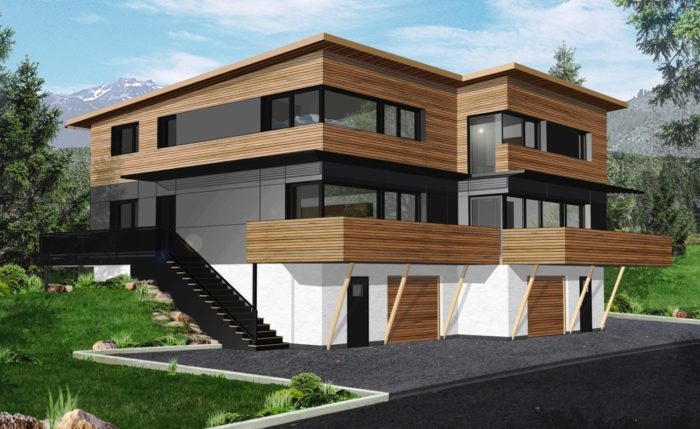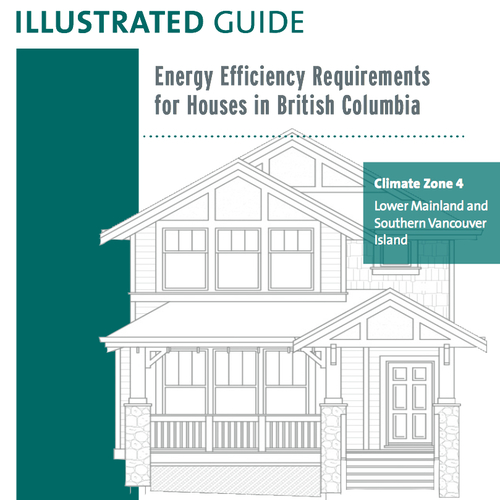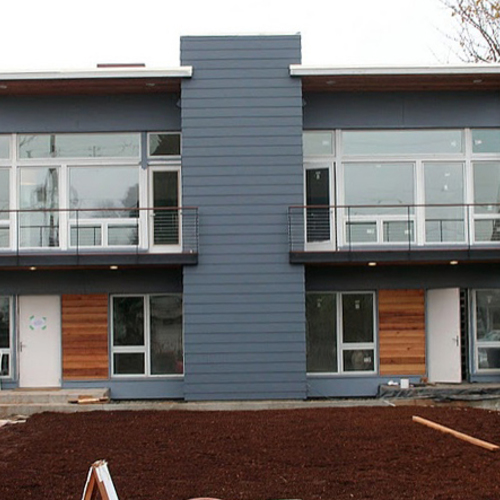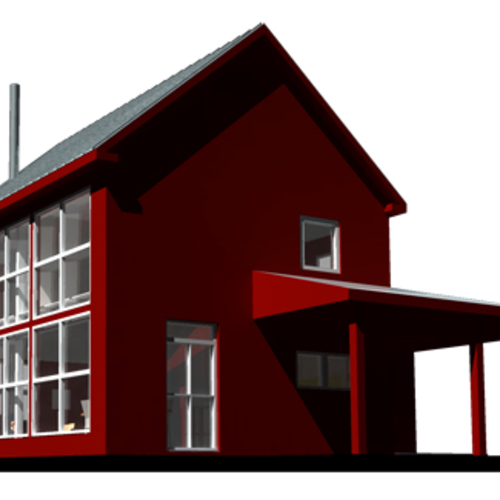
Image Credit: Marken Projects
Image Credit: Marken Projects Designer Marken Projects and builder Dürfeld Constructors, collaborators on the construction of Austria Passive House 2010, which served as a communications center for the Austrian Olympic Committee last year, are building Rainbow Duplex as part of Whistler’s Resident Housing initiative, which imposes affordability requirements and encourages construction on infill lots. Each duplex unit has four bedrooms and about 2,150 sq. ft. of interior space, including the unfinished basements. The north side of Rainbow Duplex. The Rainbow Duplex will be constructed with prefabricated panels – a major cost-control feature of the project, according to Marken Projects and builder Dürfeld Constructors. The duplex also will include solar hot water, rainwater harvesting, cross-laminated timber decking, and a high-efficiency heat-recovery system with subsoil heat exchanger and drain-water heat recovery.
UPDATED: To reflect clarification of interior sq. ft. for each unit in Rainbow Duplex.
Given all the money and marketing that went into the construction of Austria Passive House 2010 – a showcase for Austrian Passivhaus construction products and techniques that attracted a lot of attention during last year’s Winter Olympics in Vancouver, British Columbia – members of the design-and-construction team that worked on the building thought it made good business sense to apply their know-how to a residential project that not only strives for Passivhaus performance but is also affordable.
The 3,000-sq.-ft. Austria Passive House, or Austria House, as it was widely known, served as a communications center for the Austrian Olympic Committee and now is operated as an outdoor-activities center by the resort municipality of Whistler, which had donated the land for the project. Austria House cost about $1.23 million to build, including a $143,000 grant by the Whistler Blackcomb Foundation, although many of the construction materials for the project were donated by Austrian companies to help market their products.
Emphasizing housing opportunities for local employees
Builder Dürfeld Constructors, a Whistler-based company that was general contractor on the Austria House, and Marken Projects, a designer based in Vancouver, are now teaming up on an affordable-housing follow-up called the Rainbow Duplex. To help control costs, the project’s floor, walls, and roof will be built from prefabricated panels and will incorporate “as many local, renewable, and recycled materials as possible,” Marken says on its website.
Construction started just a few weeks ago, and the duplex is scheduled for completion in the fall or 2011. Each unit will include four bedrooms and two baths in about 1,450 sq. ft. of living area, plus about 700 sq. ft. of garage and basement. The project is part of the Resort Municipality of Whistler’s Resident Housing initiative, whose affordability requirements are designed to keep costs on new construction below Whistler’s (relatively high) average real estate prices, and to provide housing for the community’s resident employees. Projects in the Resident Housing program typically are built on infill lots rather than in outlying areas, in keeping with Whistler’s goal of housing 75% of its workforce locally.
A first step toward lowering construction costs
Dürfeld Constructors is building the panels – TJI joists with wood fiberboard on the outside, oriented strand board on the inside, and blown-in cellulose – to R-47 for the walls, R-67 for the main floor, and R-63 for the roof. Optiwin windows and siding will be installed before the panels are delivered to the site, Alex Maurer, a director of Marken Projects affiliate Fab-Homes, told GBA. (Fab-Homes offers a range of relatively inexpensive designs for homes that include a number of Passivhaus features.)
The units will be equipped with Zehnder 350 heat recovery ventilators and Comfofond subsoil heat exchangers. Maurer expects the per-square-foot cost for the Rainbow Duplex to come in at a little more than $200, although the design-build team has come up with ways to fine-tune the prefabricated-panel system to further reduce costs. The per-square-foot cost for a second, similar project now underway, for example, is expected to be around $170, says Maurer, who adds that most of the savings will come from significantly shortening the on-site assembly time. For a single-family project, he says, assembly of the prefabricated panels now can be completed in as little as eight hours.
Weekly Newsletter
Get building science and energy efficiency advice, plus special offers, in your inbox.














6 Comments
Branding fail
Totally admire wanting to bring high energy-performance standards to affordable housing and I really want to like this project, but what is it about not having an actual client that brings out the worst in designers? In this case the full-flight stair to the front door, the lack of personal outside space associated with each 'unit' (let's not call 'em homes) and the sixties styling all scream public housing or at best, ski lodge. Good branding job, guys. Is it that we want to make absolutely sure that no-one could mistake where the help lives for full-time market rate homes?
And shouldn't affordable housing pay a little more attention to having owner-maintainable exteriors?
"Affordable"
Is $430,000 really considered "affordable"? ($,2000/s.f. x 2,150 s.f. not including grants.) I live in resort community not unlike Whistler, and our affordable housing is capping at $250,000 or less...
Also, is 2,150 s.f. really a "Passivhaus"? For some reason, I am recalling that the original standard called for a limited amount of s.f. per person to acheive the certification.
pam,
PH certification is
pam,
PH certification is based on 377sf pp, so the house would be calc'd at 6 people. max occupant rate (in PHPP "planning" mode as opposed to verification) is 538sf pp x 4 bedrooms = 2,152sf - i believe this is so you have 'real world' numbers, as likely occupant load would be lower
Re: Some clarifications
Just some brief clarifications:
1. The basement is the garage, mechancial room and storage only - as per zoning. Living area is 1,450 sqf. on main/upper level.
2. Almost all homes in this subdivision with the same lots have exterior entry-stairways - reason: space plus (especially in our case) avoiding to have to include the entrance with stairway in the passive building envelope--> costs
3. Essentially everything below $250/sqf is considered affordable in expensive Whistler. Can certainly be done cheaper somewhere else. Developer has to meet affordability requirements set out by the WHA. No grants btw...
4. The lots in this subdivision are indeed small - maximizing FSR was crucial. Large walk-out patio garden in back though.
5. Appeal/taste is subjective. At the end of the day the market says which product is appealing and which isn't. The response is/was overwhelmingly positive, lots of interest, both units have already been presold to Whistler residents.
6. Exterior is low maintenance: Trespa and Cedar - Cedar is very popular in Whistler and we like wood! Wood only was not allowed to to fire regulations/
Re:Correction
Correction to the article: While Durfeld Constructors have been involved as the General Contractor for the Austrian Olympic Passivhaus, we have not been part of this great showcase project. Credit goes to the Austrian Passivhaus Group.
Thank you for the clarifications
Truly appreciated. We've altered the text to reflect the sq. ft. and Austria House design-and-build clarifications. The Austria Passivhaus Group principals, we should add, include the following:
- Drexel und Weiss: a supplier of HRV systems, and the Initiator of the Austria House project
- Optiwin: a supplier of windows and doors for Passivhaus buildings
- Erich Reiner: engineering consultants for the timber industry and energy-efficient construction
- Sohm-Holzbatechnik: European general contractors specializing in heavy-timber and Passivhaus construction
- Zweiraum: an Austria-based advertising agency
The architect for the Austria House project was Martin Treberspurg, of Austria
Log in or create an account to post a comment.
Sign up Log in